
Tour 3: Stroud and the Mill Valleys
Centred round the market town of Stroud, this 42-mile (68km) drive through steep valleys and dales is half a day well spent uncovering the area’s best-kept secrets
Highlights

Industrial heritage in Stroud.
Corrie Wingate/Apa Publications
This tour offers a very different Cotswold experience from that of the landscape found in the heart of the area. The circular route begins and ends in the historic town of Stroud, which played an important role in the Industrial Revolution and is located at the divergence of five valleys. These gorge-like valleys, with their fast-running streams, provided the ideal conditions for woollen mills in the 18th century, when cloth production ceased to be a cottage industry and grew to become a factory-based process. As the drive weaves its way through the valleys, there are several pretty, hidden villages and hamlets en route, as well as elegant towns that display Cotswold stone houses at their best.
STROUD
Once the centre of the industry in this area, Stroud 1[map] still has the feel of an industrial town. The centre of Stroud has been pedestrianised and there is an enviable array of specialist shops with a bohemian vibe to explore. The award-winning Farmers’ Market is held every Saturday. History trail maps can be obtained from the Visitor Information Centre (tel: 01453-760 960) located in the Subscription Rooms on George Street, a handsome classical building dating from 1833, built as its name says by public subscription as a concert hall and art gallery. It still performs this role, especially during the annual Stroud Fringe Festival, held end August/September (www.stroudfringe.co.uk).
Also of interest is Stroud’s Museum in the Park (tel: 01453-763 394; www.museuminthepark.org.uk; Apr–Sept Tue–Fri 10am–5pm, Sat–Sun 11am–5pm, Aug daily, Oct–Mar Tue–Fri 10am–4pm, Sat–Sun 11am–4pm; free). This family-friendly museum is set in a restored Georgian mansion in Stratford Park. Innovative displays feature local history and pride of place goes to the world’s first lawnmower, invented nearby in 1830.
Two of the town’s surviving woollen mills are open to the public: Dunkirk Mill, where a working water wheel can be seen driving textile machinery; and St Mary’s Mill (for both mills tel: 01453-766 273; www.stroud-textile.org.uk; days and times are restricted, call or check the website for details; charge).
THE NAILSWORTH VALLEY
From Stroud heading south on the A46 to Nailsworth, you pass Rooksmoor Mills (1820), Woodchester Mill and, finest of all, with its French-château-style clock tower, Ebley Mill (now home to Stroud District Council). The latter was built in 1818 and extended by G.F. Bodley, the church architect, in 1865.
In the vibrant little town of Nailsworth 2[map], the mill theme continues, with the late 18th-century Clothiers Arms (tel: 01453-763 801) and mill-workers’ cottages. Nonconformism came early to these valleys, and Chestnut Hill has a fine Quaker Meeting House dating from 1689. At the bottom of the valley, Egypt Mill (now a hotel and restaurant) was a corn mill that was later used for cloth dyeing, while on the Old Bristol Road Ruskin Mill (tel: 01453-837 500) is now a college. It has a coffee shop serving organic food and an exhibition gallery showing the work of violin- and cabinet-makers, jewellers, sculptors and other artists.
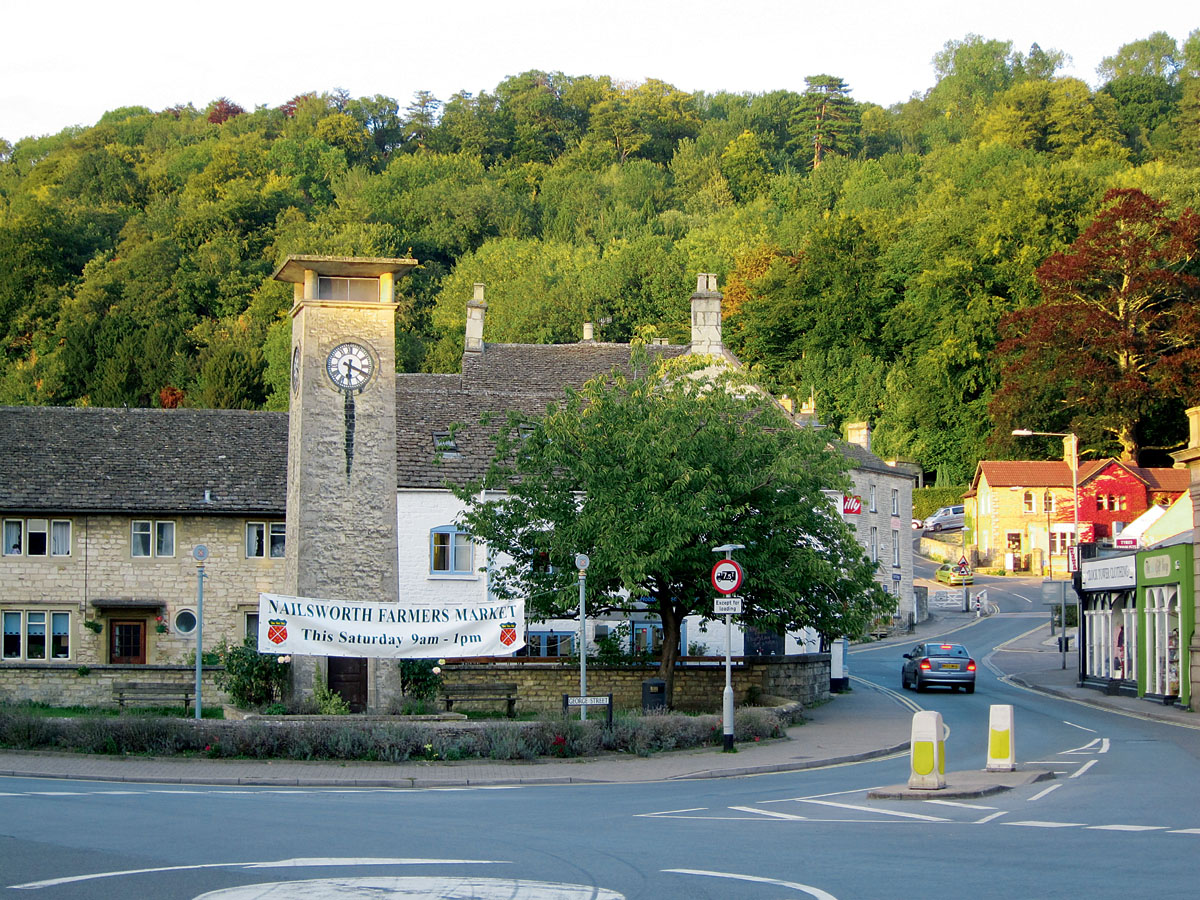
Clock tower and war memorial in Nailsworth town centre.
Corrie Wingate/Apa Publications
Alternative Town
Stroud has led the way since 1990 as a thriving alternative centre proud of its green credentials. Shops selling organic food and sustainable goods are plentiful in the town. Ecoshop (Stroud Valleys Project) at 8 Threadneedle Street has eco-friendly products to help you live a sustainable life. Stroud also has Britain’s first organic café, Woodruffs (for more information, click here), while the nearby valleys are home to a growing community of artists and New Agers.

Amberley is within easy reach of several other mill towns and has lovely views of the valleys.
Corrie Wingate/Apa Publications
From Nailsworth, very steep roads climb to the extensive limestone grasslands of Minchinhampton Common. Heading for Amberley, you will pass through the one-street hamlet of Watledge, the last home of W.H. Davies, who wrote about his wanderings in Britain and America in Autobiography of a Super-tramp (1908), and penned the immortal couplet: ‘What is this life if, full of care, We have no time to stand and stare’. At the junction turn right for Amberley.
Amberley is where the Victorian novelist Maria Craik wrote much of her novel John Halifax, Gentleman (1856), setting chapters against the background of the local mills. Unfenced roads lead across the common, a popular spot for picnics, kite-flying and horse riding in summer. Parts of the common are rich in rare limestone wild flowers in summer, including harebells, rockroses, orchids and stemless thistles.
Minchinhampton
Following signs for Minchinhampton, you pass the ditches and banks known as the Bulwarks, thought to have been defences thrown up in the 1st century AD by local Iron Age tribes to halt the advancing Romans.
Minchinhampton 3[map] was another prosperous wool town, and the scores of ancient tracks that converge here were used by packhorses bringing wool for sale from nearby farms. The pillared Market Hall (1698) has survived, surrounded by fine 17th- and 18th-century houses. The church spire, oddly truncated, was in danger of collapsing so it was reduced in height in 1563 and given a stone coronet. The south transept is a triumph of the 14th-century Decorated style, with a lovely rose window and unusual stone scissor-bracing.
Avening
Heading southeast to Avening, the road skirts the boundary of Gatcombe Park, home of the Princess Royal. Avening 4[map] was another village that prospered on the cottage-based industry of skilled spinners and weavers. The fine church, of Saxon origin, contains a monument to Henry Brydges (died 1615), who was a notorious pirate, smuggler and highwayman until he married the daughter of a prosperous Avening clothier.
Just before Avening turn east on a minor road. The next village, Cherington, has several more 18th-century clothiers’ houses, distinguished buildings of stone with moulded eaves, architraves and cornices. From Cherington village centre turn left and take the next narrow lane signed Sapperton, skirting Aston Down airfield, a favourite spot for launching gliders, to descend into another valley system, where the route crosses the A419 to Frampton Mansell.
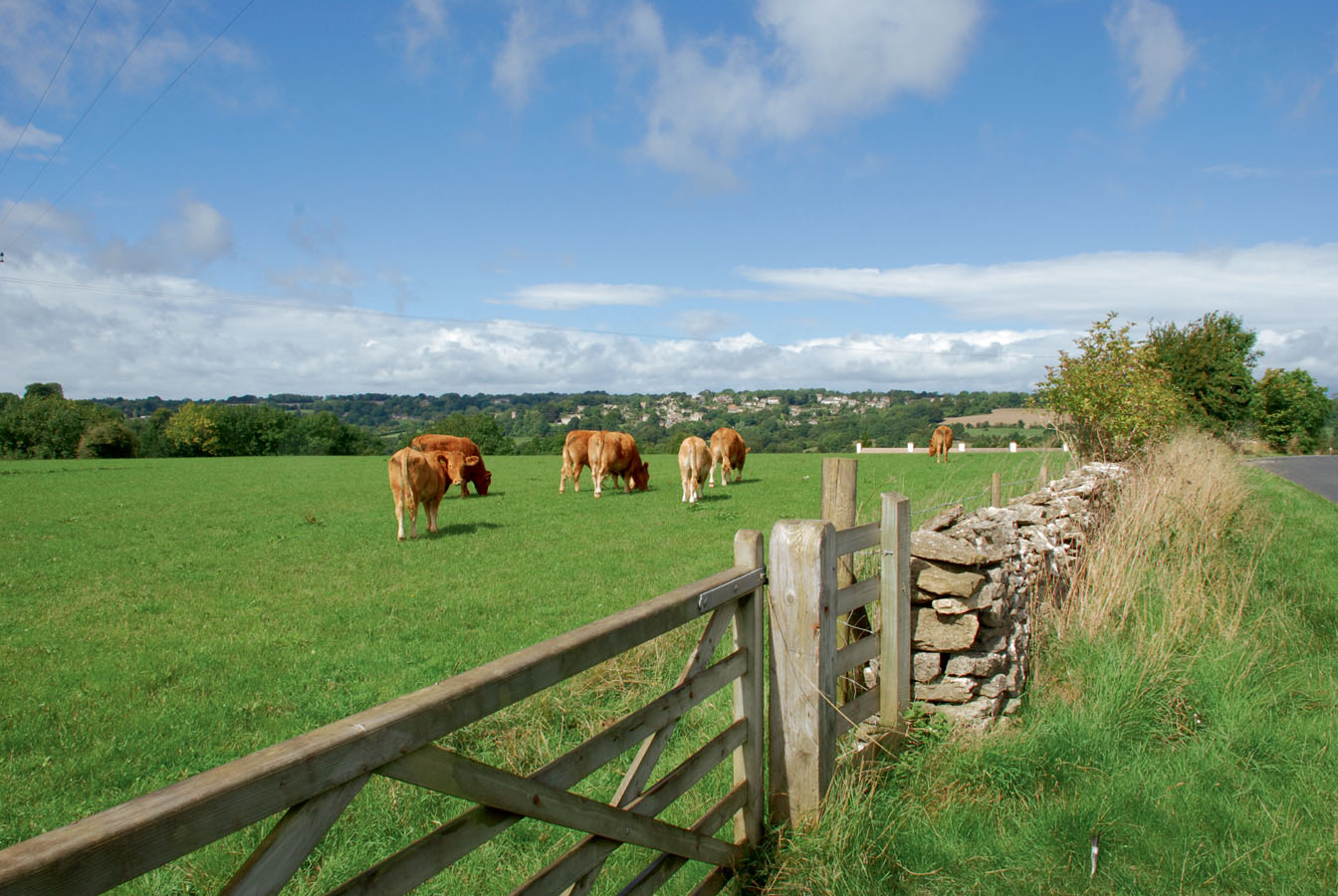
Cows graze on the plateau just above Frampton Mansell and the Golden Valley.
Corrie Wingate/Apa Publications
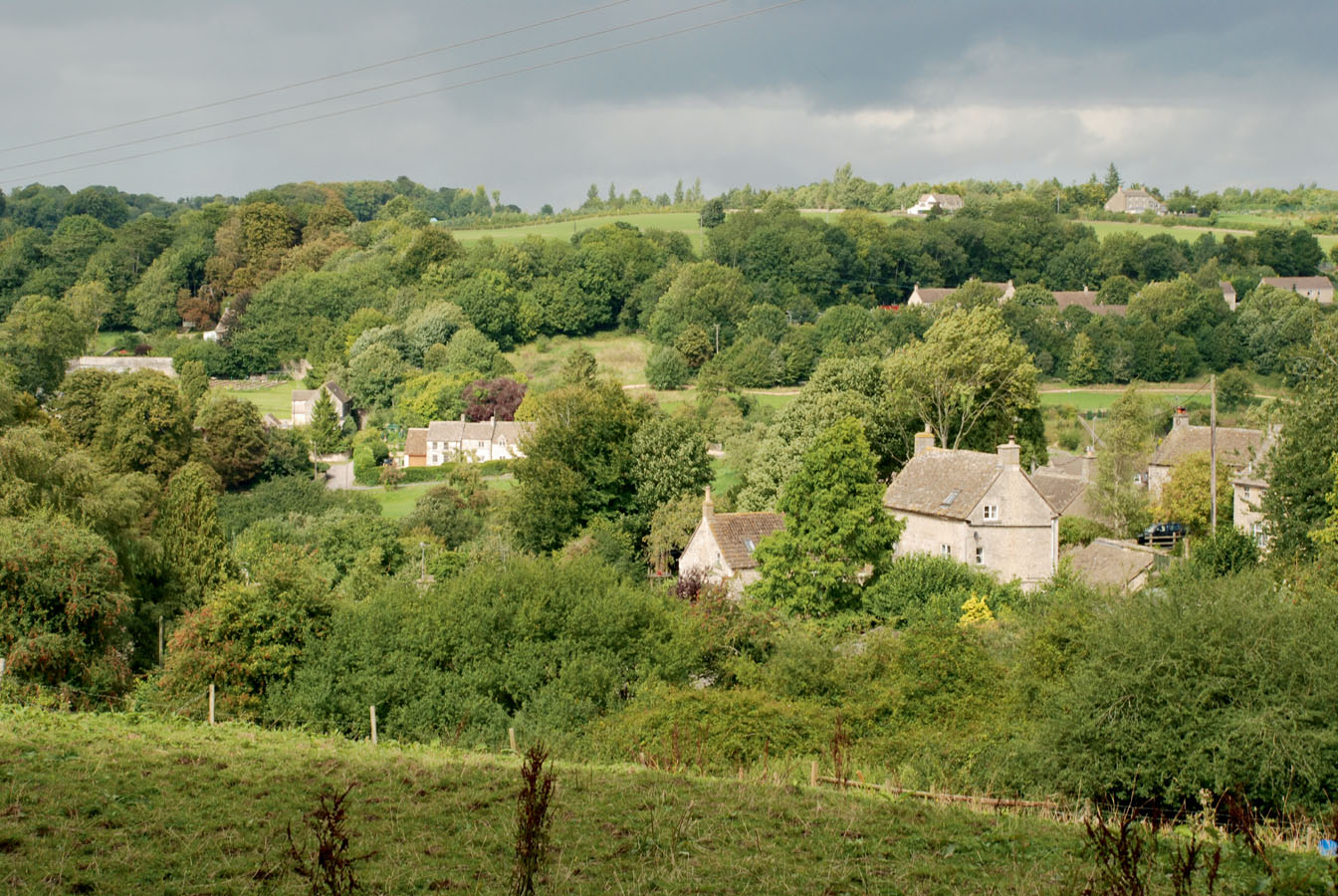
Picturesque Avening once had a thriving cottage industry of spinners and weavers.
Corrie Wingate/Apa Publications
THE GOLDEN VALLEY
There are fine views from Frampton’s neo-Norman church (1844) over the Golden Valley – in autumn the beech trees that clothe the valley’s sides turn to gold. Frampton is a good spot to park for walking the Thames and Severn Canal Path in the valley bottom.
Canal Path Walk
The Thames and Severn Canal was built to link the River Severn with the River Thames (at Inglesham Lock). The canal’s working life was short-lived because water continually leaked into the porous limestone, and in 1876 the Great Western Railway, whose track still runs parallel, bought the canal to prevent any rival company building another track along its course. Since then the canal has been left to nature, and walking the towpath can be a challenge, but it will bring you close to moorhens, coots and grebes, dank lock basins alive with midges, sunny pools where dragon- and damselflies hunt for prey, and bogs fragrant with watermint or musk. Enjoy this natural wilderness while it lasts: the Thames and Severn Canal Restoration Trust has financial backing to restore the canal to full working order.
Take the narrow road downhill in front of the Crown Inn (for more information, click here) and cross the railway line to pick up the path. Heading west takes you past natural lakes formed by the River Frome, which runs alongside the canal for much of its length. At Chalford there are several historic mills grouped around the former wharf, as well as a canal roundhouse, once occupied by the lengthman, whose job it was to maintain a length of the canal. If you go east, you will pass the Daneway Inn (for more information, click here) before reaching the Sapperton end of the rock-cut canal tunnel, framed by an imposing classical portal. From here, boats would be propelled the 2½ miles (4km) through the tunnel to the Coates end by leggers, who lay on their backs and ‘walked’ along the tunnel walls.
Sapperton
The driving tour continues to Sapperton 5[map], built on a series of terraces overlooking the Golden Valley. There are several good walks from the village, including the woodland path to Pinbury Park, the home of the poet John Masefield, and the place where Ernest Barnsley, Sidney Barnsley and Ernest Gimson first set up their Cotswold Arts and Crafts furniture-making workshops. All three are buried in the churchyard at Sapperton. The church itself, rebuilt at the beginning of the reign of Queen Anne, has big round-headed windows and pews made from Jacobean carved woodwork, recycled when Sapperton House was demolished in 1730. Also of note are two fine Renaissance tombs, one to Sir Henry Poole (died 1616) and the other to Sir Robert Atkyns (died 1711), author of the first history of Gloucestershire, which he is holding. Retrace the route to the crossroads and turn right, following signs to Bisley, about 3 miles (4.5km) further on.

Remnant of the industrial age at Chalford, where historic mills are grouped around the old wharf on the Thames and Severn Canal.
Corrie Wingate/Apa Publications
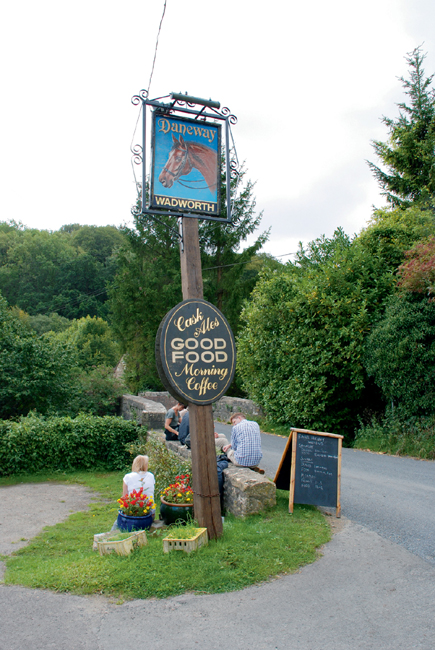
Outside the Daneway Inn below Sapperton.
Alamy
At Daneway, in the valley below Sapperton, the steep hillside to the north of the Daneway Inn (for more information, click here) is covered in grassy tussocks indicating the presence of old ants’ nests, characteristic of unimproved Cotswold grassland. These fields, known as the Daneway Banks, now form part of a Gloucestershire Wildlife Trust reserve where you can see several varieties of orchid in summer.
Bisley
A steep road runs northwest of the Banks and through beech woodland to the delightful village of Bisley 6[map], where footpaths thread their way between dry stone walls sheltering colourful cottage gardens in the vicinity of the fine 15th-century church. Thomas Keble (brother of John Keble, the Oxford Movement founder, vicar here from 1827 until his death in 1875) introduced the annual well-dressing ceremony held on Ascension Day, based on the spring-fed stone tanks in the lane south of the church. The novelist Jilly Cooper lives in this village.
THE SLAD VALLEY
To reach the secluded Slad Valley (for more information, click here), leave Bisley village northwest on Stroud Road to join Bisley Road and then take the very narrow lane on the right, signposted Catswood, about half a mile (1km) outside the village. Not much more than a track in places, the road twists and turns passing a disused quarry, now a Gloucestershire Wildlife Trust reserve with many species of orchid, adders, lizards, butterflies and rare grasshoppers. At the end turn right to pass through Slad 7[map] (for more information, click here) and take the next left signposted Painswick.
Life in Slad
Poet and novelist Laurie Lee lived most of his life in the village of Slad and was best known for his autobiographical trilogy. The first volume was Cider with Rosie (1959) which depicts life in Slad at the end of World War I. An adaptation of Laurie Lee’s story was televised by the BBC in 1970 and again in 1998 by the former Carlton Television. The story has since also been adapted for radio and the stage.
The Large Blue
Extinct in the UK since 1979, the Large Blue butterfly has been succesfully reintroduced at Royal Bank overlooking the Slad Valley, a region where it has not been seen for 50 years. It is believed that, due to climate change, the Cotswolds offers the best environment for the butterflies to thrive, with warmer conditions ideal for the red ants on which they rely for food at the caterpillar stage.
If you prefer a less arduous route, just before the narrow lane, branch left on Stancombe Lane, following signs for The Camp, and continue to the junction with the B4070. Turn left and after about 2½ miles (4km) turn right to Painswick – you are now back on the same route.
THE PAINSWICK VALLEY
From Slad it is a short drive down a steep single-track road to Painswick 8[map], often described as the ‘Queen of the Cotswolds’ because of its elegant and harmonious groups of classically inspired Cotswold stone houses. This, too, was a wool town, and the Painswick Brook, at the bottom of the valley, has several former fulling mills, now converted to apartments.
The magnificent churchyard is famous both for the 99 topiary yews, which form a series of avenues leading to the church, and for the unusual collection of tea-caddy and table tombs. These are mostly the work of 18th-century masons, and they are carved with all kinds of Baroque decorative devices, including cherubs, fruit and flower swags, pie-crust frills, scrolls and shells. The church contains a number of curiosities, including graffiti carved into a pillar in the north nave by an imprisoned Puritan soldier during the 1643 siege of the village. It quotes from Edmund Spenser’s The Faerie Queene – ‘Be bolde, be bolde, be not too bold’. Painswick celebrates its ancient Clypping Ceremony on or around 19 September, when children from the parish link hands to form a circle right round the church (clipping derives from clyppan, meaning to embrace) while singing songs.
Britain’s oldest Bowling Green (over 400 years old), is located at the back of the Falcon Inn in Painswick. The flat green, established in the 16th century, was originally used for gentlemen to wind down after a day of hunting in the nearby Cotswold countryside.

The Woolpack in Slad, a welcoming 16th-century watering hole, once frequented by Laurie Lee.
Alamy

Clear directions to amenities in elegant Painswick, a town often described as the ‘Queen of the Cotswolds’.
Corrie Wingate/Apa Publications
The Gardens
Drive through the centre of town and on the northern outskirts of Painswick, on the B4073 Gloucester road, is the entrance to the Painswick Rococo Garden (tel: 01452-813 204; www.rococogarden.co.uk; mid-Jan–Oct daily 11am–5pm; charge). A rare survivor from the early 18th century, it represents the transition in styles from the formal to the natural landscape schools of gardening. Dotted with temples and gazebos and a maze celebrating its 250th anniversary, the garden enjoys a naturally dramatic setting in a sheltered combe, with woodland on all sides. The garden is magical throughout the year, and is particularly breathtaking in late January/early February when snowdrops appear. The Coach House Restaurant serves lunches and tea.
Viewpoints
Bearing left on a concealed single-track road, soon after a sign for Painswick Beacon (for more information, click here), will take you in a big loop via a viewpoint at Cud Hill. The narrow road eventually meets the A4173. Head south and almost immediately take the next right, which works its way through more rural lanes, and eventually turn right again towards Haresfield. Here the views to the south look over a patchwork of dairy farms and orchards to the silvery Severn, while to the north they stretch along the escarpment to Cheltenham and beyond. As the road descends into the flat vale you arrive at Haresfield, where the Tailor of Gloucester, John Prichard, lived later in life as a schoolmaster. The church has some good monuments inside and fine table tombs outside.
Painswick Beacon
Above the town of Painwick, just north of the Rococo Garden, this viewing point offers spectacular views right across the Severn valley and takes in the Welsh mountains in the distance. On the top of the beacon the outlines of a large Iron Age hillfort can be seen. The fort is triangular in shape and has double banks and ditches on three sides.
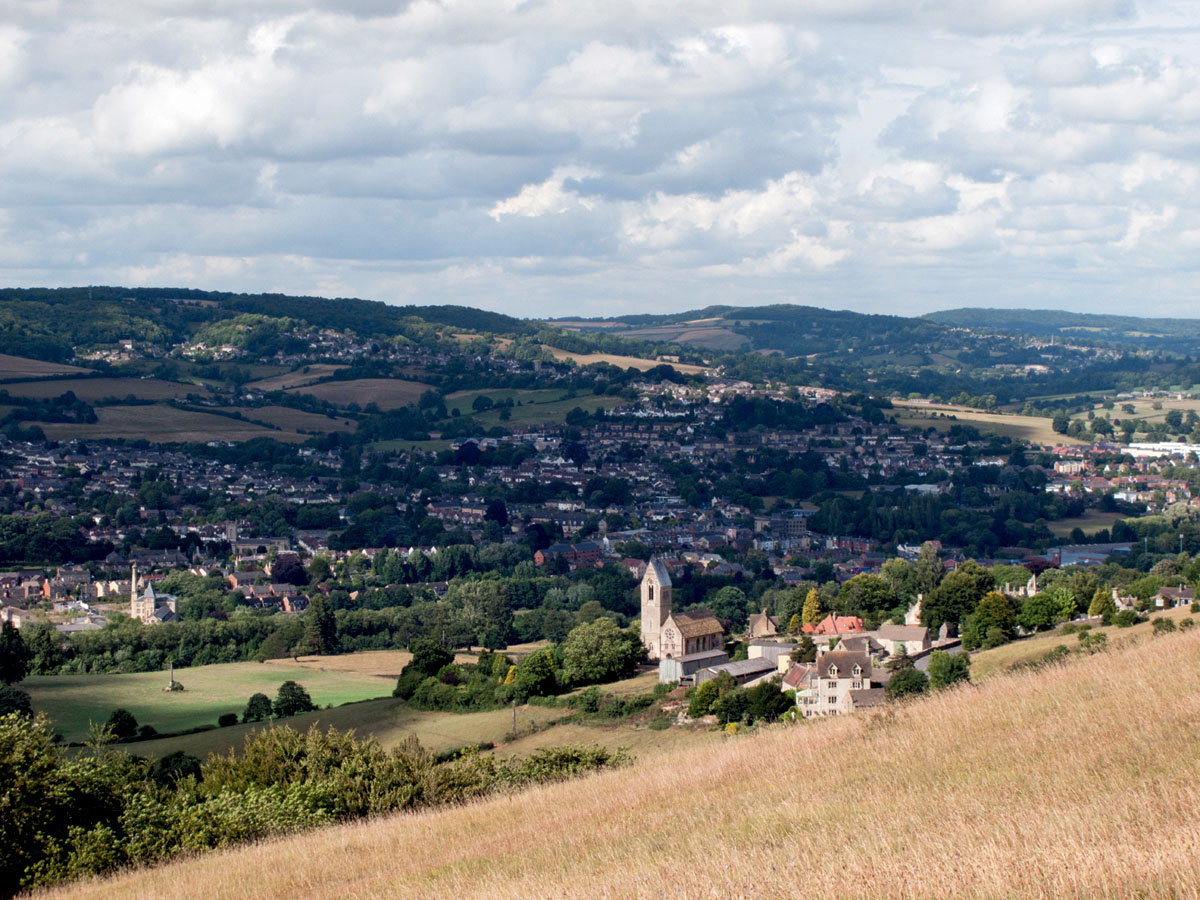
A rambler’s view from the Cotswold Way over Selsley village and church to Stroud.
Fotolibra
RETURNING TO STROUD
At the next junction turn right, then left (signed Gloucester), and left again for Standish. Standish Church, where the boldly carved skeletons and cherubs have escaped weather erosion, also has some good monuments and tombs. Inside there is a splendidly painted memorial to Sir Henry Winston, an ancestor of Sir Winston Churchill.
The Stanleys
Continue to Stonehouse, from where you cross the 18th-century Stroudwater Canal on the way to Leonard Stanley, where the parish church once served the monks of the Augustinian priory of St Leonard, founded in 1121. The fine Romanesque capitals of the chancel depict the Nativity and Mary Magdalene drying the feet of Jesus with her hair. The original parish church (of Saxon origin) still survives in use as a cart shed in the adjacent farmyard, along with a 14th-century monastic barn and fishpond (they can be seen from the western end of the churchyard).
The tour continues south to King’s Stanley 9[map]. Straddling the River Frome, the magnificent Stanley Mill has been restored with funding from English Heritage. It’s a pioneering example of fireproof construction: iron and brick were the main materials used when it was built in 1815, and wood was banned altogether.
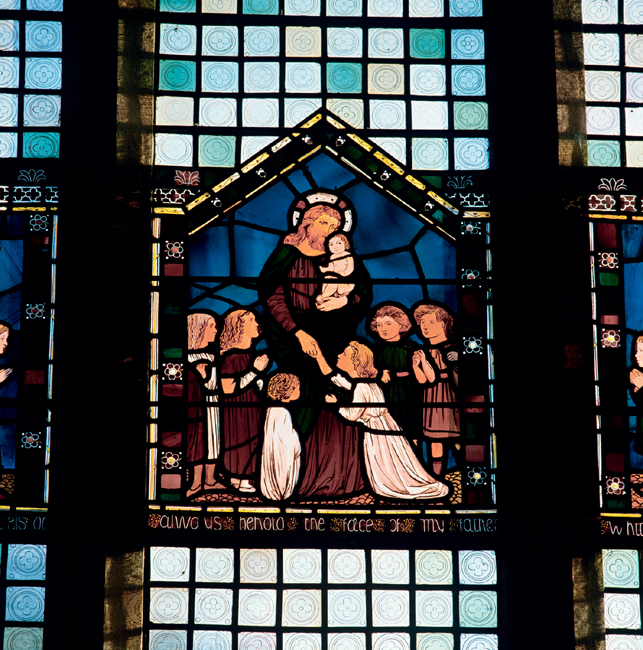
Detail from one of the splendid Arts and Crafts stained-glass windows in Selsley Church.
Alamy
Selsley Church
Further south from King’s Stanley, left at a mini roundabout, a narrow road climbs through Middleyard to Selsley )[map] and one of the Cotswolds’ most delightful Victorian churches. The church and the adjacent house were built by Sir Samuel Marling, owner of Ebley Mill, whose French-style clock tower is visible in the valley as you look to the right across the churchyard. Marling had once visited the village of Marlengo in the Austrian Tyrol, because of its similarity to his own name. He decided Selsley was sufficiently alpine in feel to justify the construction of a church based on that at Marlengo; the result is this striking building designed by the architect G.F. Bodley in 1862. The stained glass here was the first to be designed by the then newly formed firm of Morris & Co. William Morris, Philip Webb, Ford Madox Brown, Dante Gabriel Rossetti and Edward Burne-Jones all had a hand in the design of the lively and colourful Creation window that fills the west gable. From Selsley it is just a short drive back to the centre of Stroud.
Eating Out
Stroud
Woodruffs Organic Café
24 High Street; tel: 01453-759 195; www.woodruffsorganiccafe.co.uk; Mon–Sat 8.30am–5pm.
For health-conscious eaters, this organic café is an excellent spot for afternoon tea or a full-on lunch. £–££
Nailsworth
Egypt Mill Hotel and Restaurant
Stroud Road; tel: 01453-833 449; www.egyptmill.com; daily 10am–9.30pm.
In a lovely riverside setting, the restaurant has wooden floors, birdcages dangling from the ceiling and a working mill on show. The menu intertwines great British ingredients with food from across the world. ££
Frampton Mansell
The Crown Inn
Frampton Mansell; tel: 01285-760 601; www.thecrowninn-cotswolds.co.uk; food served Mon–Sat noon–2.30pm, 6–9.30pm, Sun noon–8.30pm.
A quintessential village pub in a 17th-century cider house, with open fires, stone interiors, a friendly environment and refined pub grub. Fine views. ££
Sapperton
Daneway Inn
Daneway; tel: 01285-760 297; http://thedaneway.com; daily 11am–2.30pm, 6.30–11pm, closed Mon eve.
Hearty dishes such as beef and Guinness pie are huge crowd pleasers at this charming pub with original features and a large garden edging the now derelict canal. ££
Bisley
The Bear
George Street; tel: 01452-770 265; www.bisleybear.co.uk; food served Mon–Sat noon–2pm, 6–9pm, Sun noon–3pm.
The epitome of a 16th-century inn: oak settles, brass and copper, stone fireplace, and low ceiling. Tasty meals can be enjoyed outside on the flag-stoned courtyard. £–££
Painswick
JK’s @ St Michael’s
Victoria Street; tel: 01452-813 832; www.jks-restaurantco.uk; Wed–Sun noon–3pm, 7–10pm.
In a 17th-century listed building, this cosy restaurant run by two local chefs who support local farms offers modern cuisine with a twist. £££